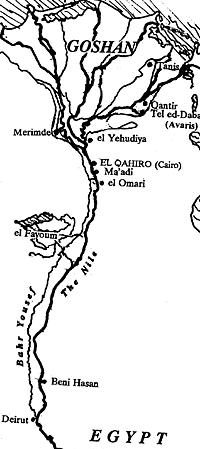Let's first take a glimpse at the Ma'adi culture.

It is an Egyptian predynastic culture (and the type site) of the northern region (i.e., the lower Nile river delta), from about 3900 - 3500 BCE, consisting of small, unimpressive (considering the later Egyptian societies) agricultural villages, with some copper imports, probably from the region of the Negev.
Maadi
In Lower Egypt, a predynastic site was uncovered in the 1930's by Menghin and Amer. It was named Maadi and had apparently been occupied from 3600 BC to 3000 BC. It is located near the southern suburbs of Cairo, Egypt.
Maadi is a unique predynastic site. It is located on what used to be the Wadi el-Tih, an historical route to the copper mines of the Sinai Peninsula. There is also evidence of foreign house styles and pottery, domesticated donkeys, intricate storage facilities and an advanced copper industry. In 3600 BC, foreign trade goods started to reach Egypt having a great effect on the communities in Lower Egypt. The prosperity of the trade networks later lead to vast settlements in Egypt such as Memphis and the settlement at Cairo.
The Maadi settlement covered about 45 acres of land. Almost all of the houses were oval in shape and constructed with post walls and mud-daub wicker frame. Strangely enough, some of the homes were constructed underground. These homes had entrances through a slanting passage with steps that were faced in stone. The posts for these homes were driven into the ground to support the roof which was made of light-weight material such as woven mats. In the center these homes had sunken hearths.
Unlike many of the grave sites in Egypt, the Maadi culture had very simple burials. These types of burials have distinguished the Lower societies from the Upper societies in Egypt. generally, the grave sites are located south of the settlement about 1 km. In the 1950s, 468 burials were discovered over an acre of land.
The graves were very simple. They were very shallow circular or oval pits. Some of the pits were covered by large limestone blocks. The Maadi culture buried some possessions with their deceased loved ones. Artifacts found in the graves were pots, both red and black ceramics, stone vases made of alabaster, limestone, and basalt. Flake-blade tools, trapezoidal and rhomboidal palettes were also uncovered. Jewelry such as bracelets and combs were found, along with shell containers. They also buried objects of trade in the graves, such as ornamental carnelian traded from the eastern desert, colored stone bead and traces of malachite and manganese which were probably used as pigments. Even though the Maadi were settled on the trade routes for copper, very few graves contained copper in them. The possible explanation for this was that they viewed copper as an essential element of living considering it a waste to bury it with the dead.
The Maadi settlement was a stepping stone that allowed other cultures to flourish. The site was well preserved and a wonderful find in the archaeological world. Unfortunately this site was not widely publicized when it was uncovered and little has been written about it since.
Bibliography:
http://www.users.directonline.net/~archaeology/EgyptionPredynastic.html
Lesko, Leonard H. 1993. The World Book Encyclapidia. Pages135-144. World Book, Inc., Chicago, London, Sydney, Toronto.
By: Kate Stensrud
There is much public interest in the archaeology and history of this place, due to the Biblical account of the Hebrews in ancient Egypt.
Early Semitic Presence in Egypt
Between 5000 and 3500 BCE Asiatic settlements were established further up the Nile in enclaves along the river which were periodically flooded. Sun-dried bricks, a characteristic Mesopotamian building material, were first employed in Egypt during this period; the use of the distinctly Mesopotamian cylinder seal was introduced, and traces of writing appeared; they bore a marked resemblance to those of the Land of the Twin Rivers (Mesopotamia).
"The first attempts at a pictographic system of writing have also been traced... to the Jamdet Culture [of Mesopotamia]."10
During this period it is evident that Asiatic traders had already threaded their way past the indigenous Egyptians of Upper Egypt by boat and donkey to trade with the Nubians. The donkey was alien to Egypt. The Egyptians, in fact, had no pack animals during the entire Pre-dynastic period. The earliest remains of donkeys were found in various communities of Asiatic origins in the Delta. Donkeys were conspicuously present in Ma'adi, a village of Asiatics which was established south of present-day Cairo. Significant evidence of trade both with Asia and Nubia was found among the artifacts recovered from its ruins.
The Ma'adians were not only expert in agronomy and husbandry but were accomplished metallurgists and craftsmen. "A copper axe-head spoiled in casting and masses of copper ore indicate that copper was being processed at Ma'adi. Ma'adi is the oldest site in northern Egypt in which copper artifacts have been found."11
The people of Ma'adi were among the many communities of Asiatic peoples who had been active in northern Egypt for several millennia at the time it was invaded and destroyed. They suffered a cruel thanks for the technology, agronomic and industrial, that they had introduced into Egypt. "Ma'adi met a violent end as witnessed by widespread ash and human bones over the settlement. If so, then perhaps this was the 'final solution' arranged for the heterogenous society of Ma'adi by the victorious kings of the First Dynasty."12
Notes
10 H. J. Cantor, "The Relative Chronology of Egypt and its Foreign Correlations before the Bronze Age," in Chronologies on Old World Archaeology, ed. R. Ehrich, Chicago Un. Press, 1965, pp. 1-46.
11 B.G. Trigger et al, "The Rise of Egyptian Civilization," in Ancient Egypt: A Social History 1983, reprint Cambridge Un. Press, 1986, pp. 25-6.
12 Hoffman, Ibid., p. 214.


